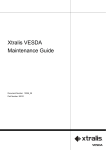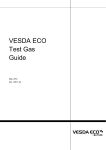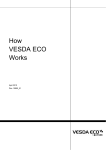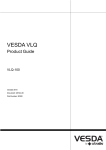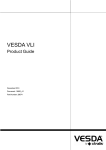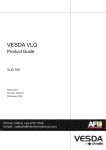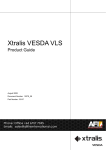Download Refrigerated Storage Sampling Kit
Transcript
Refrigerated Storage Sampling Kit Application Note December 2012 This page has been left blank intentionally. VESDA® Refrigerated Storage Sampling Kit Preface Xtralis has developed the Refrigerated Storage Sampling Kit for use in Refrigerated Storage facilities protected by VESDA detectors. The information contained in this document will assist in the installation and maintenance of the Refrigerated Storage Sampling Kit in Refrigerated Storage facilities. Related Products o VESDA detectors Copyright ©2012 Xtralis (Aust) Pty Ltd i Refrigerated Storage Sampling Kit This page has been left blank intentionally. ii VESDA® VESDA® Refrigerated Storage Sampling Kit Background Refrigerated Storage facilities are unique and challenging environments for any smoke detection system. They are characterised by varying low temperatures and frequent traffic from workers on picking machinery in and out of the temperature controlled rooms. While most have some form of fast acting automatic doors or plastic barrier curtains to limit warm air ingress, it is inevitable that warm air will enter the facility. This constant traffic flow with regular warm air ingress often creates condensation within the temperature controlled rooms and thus icing occurs. Ice tends to form on any and all ceiling mounted equipment and structures generally within close proximity to the entry points. Over time Aspirating Smoke Detection (ASD) sampling points and pipe within this area can become blocked causing airflow issues and inoperative detection of smoke. The maintenance required to rectify this problem (i.e. unblocking of holes or pipes) can be very costly and in some instances the simplest solution is to replace the blocked section of ASD sampling pipe with new pipe. These types of issues may not be able to be rectified during normal service callouts and may require considerable time, labour and lifting equipment accessing ASD pipes to carry out the work. There is a strong demand from both existing and new Refrigerated Storage facilities for an effective and easy to install and maintain means of ASD sampling arrangement in these facilities. The Xtralis Refrigerated Storage Sampling Kit provides a standardised method of smoke sampling for Refrigerated Storage facilities in a considerably improved manner allowing simplified installation with reduced maintenance, thus promoting more reliable and hassle-free operation. Refrigerated Storage Sampling Kit Usage The Xtralis Refrigerated Storage Sampling Kit has been designed to replace standard cone-shaped sampling nozzles installed at the ceiling in existing or new Refrigerated Storage facilities. This kit can be installed in the entire facility or combined with standard sampling points (nozzles) if required. The aim here is to reduce direct ice blockage of the sampling points and as such this kit is recommended for installation in areas where higher humidity is likely to occur as a result of vehicle and pedestrian traffic, e.g. areas close to doorways, perimeter of the facility, etc. This kit shall be treated as a standard sampling hole in the VESDA system design, in terms of system parameters, e.g. sampling hole location, hole size, transport time, sampling hole sensitivity, etc. Key Benefits Unlike the existing practice of installing the ASD pipes inside the Refrigerated Storage facility, the Xtralis Refrigerated Storage Sampling Kit: Enables the ASD pipe to be installed, inspected and maintained outside the Refrigerated Storage facility (i.e. within the roof space) hence enabling fire contractors to work in ambient conditions most of the time. Eliminates the need for using expensive HDPE (high density polyethylene) pipe inside the Refrigerated Storage facility. 1 VESDA® Refrigerated Storage Sampling Kit Eliminates the on-going need for costly access high lifting equipment hire for service/maintenance. Minimises the need for heat tracing. Is less prone to blockage due to icing. Provides a generally more robust ASD installation for these unique environments. Provides considerably improved aesthetics. Minimises the need for “Back Flush” system. Offers all round cost savings. Materials and Structures The sampling kit consists of outer and inner parts with sampling pipe penetrating Refrigerated Storage sandwich panel. A typical set-up is shown in Figure 3. (a) Above roof (b) Inside temperature controlled room Figure 1 – Illustration of the sampling kit The sampling pipe through the sandwich panel is made of ABS plastic and is suitable for low temperatures down to -40 °C (-40 °F). The material of the inner part (Figure 1 (b)) is Silicone, which is also suitable for low temperatures down to -40 °C (-40 °F). The installation of the pipe through the sandwich panel and individual components are shown in Figure 2. 2 VESDA® Refrigerated Storage Sampling Kit (a) Upper flange (b) Lower flange Figure 2 – Components of the sampling kit The restriction assembly, containing a sampling orifice within a socket union, is shown in Figure 3. Figure 3 – Restriction assembly System Installation Procedure 1. Check and determine the sampling hole locations as per the VESDA system design. Mark the penetration locations on the top of the sandwich panel (within the roof space). 2. Drill a 25mm (1”) core hole through the metal surface of the sandwich panel (within the roof space). 3. Drive a sharpened 6mm (1/4”) pointed steel rod centrally through the foam material until it indents or protrudes through the underside of the panel. 4. Drill a 25mm (1”) core hole through the underside of the sandwich panel where the steel rod protruded. 5. Using an off-cut of 25mm (1”) conduit, drive the conduit from the top through the foam until it protrudes through the underside of the sandwich panel. Note the conduit inner edge can be bevelled with a rat tail file to ensure a clean cut. 6. Insert the sampling pipe (330mm (1ft) in length approximately) into the hole with the aid of spring fingers to retain the pipe in the hole. Clean the surface and secure the flange to the sandwich panel using three (3) of the self-tapping screws provided. Attach the flange to the conduit using the metal clamp provided. 3 VESDA® Refrigerated Storage Sampling Kit 7. Mount the lower flange on the bottom of the hole (inside the temperature controlled room). Clean the surface and secure the flange using the remaining three (3) self-tapping screws provided. 8. Ensuring all surfaces are clean and dry, apply sealant (a polyurethane based adhesive recommended) through inlet holes on both top and bottom flanges, see Figure 4. Figure 4 – Applying sealant 9. Fit the inlet to the inner gland (bottom flange) which also plugs the adhesive inlet hole, see Figure 5. Figure 5 – Mounting of inlet 10.Mount the restriction assembly, by using the restriction disc (plate) with the required hole size, see Figure 6. Figure 6 – Installation of the restriction plate 11.Connect the sampling kit to the pipe network via the flexible tube provided. 4 VESDA® Refrigerated Storage Sampling Kit 12.Apply insulation material outside the kit and the flexible tube if required as per environmental condition. Important Note: Install all the other parts of the VESDA system as per the design and follow Xtralis VESDA system installation guidelines. Commissioning Transport time measurement can be conducted in the same way as that for on standard sampling holes. Therefore, the standard commissioning procedure suggested in Xtralis Design Guide of Refrigerated Storage (Doc No.: 11723_11) shall be followed. Maintenance Air Back Flushing (optional) Given the unique design of the Xtralis Refrigerated Storage Sampling Kit, the undertaking of regular ‘Back Flushing’ of the VESDA system pipe network is generally not required, since ice is unlikely to form over the sampling hole, as can be the case with standard sampling holes. However, facility management can at their discretion introduce back flushing as part of their normal operation to assist with maintaining the performance of the system. Back flushing can be achieved manually or automatically. The designs can vary in configurations and operation. The frequency of operation will depend on the environmental conditions of the Refrigerated Storage facility. The procedure for manual back flushing can be found in the Xtralis Design Guide of Refrigerated Storage. The connection of an automatic back flushing system is shown in Figure 7. Figure 8 shows the components and layout of a commercial purging system. Figure 7 – Automatic back flushing system 5 VESDA® Refrigerated Storage Sampling Kit Figure 8 – Commercial purging system Cleaning the Sampling Kit The maintenance/cleaning of the Refrigerated Storage Sampling Kit may still need to be undertaken periodically subject to the Refrigerated Storage facility conditions, i.e. the rate at which ice may form overtime in the facility. The cleaning of the Refrigerated Storage Sampling Kit is considerably easier and much quicker than standard sampling points. It can be done from within the roof space, providing a distinct advantage over having to enter the Refrigerated Storage facility and conduct the required work at ceiling height. The cleaning procedure consists of the following steps: Disconnect the kit from the main sampling pipe in the roof space, by opening the restriction assembly; Check possible ice formation on the sampling hole and clean if necessary; Inspect the inner wall of the sampling pipe through the sandwich panel. If ice formation is visible, clean by inserting a rod of an appropriate diameter; After cleaning, reconnect the restriction assembly and then connect to the main pipe. Ensure proper sealing is maintained. Important Note: 6 Inspection should be carried out periodically. Intervals will be determined by the icing conditions in the Refrigerated Storage facility. VESDA® Refrigerated Storage Sampling Kit Disclaimer on the Provision of General System Design Recommendations Any recommendation on system design provided by Xtralis is an indication only of what is considered to be the most suitable solution to meet the needs of the common application environments described. In some cases the recommendations on system design provided may not suit the unique set of conditions experienced in a particular application environment. Xtralis has made no inquiry nor undertaken any due diligence that any of the recommendations supplied will meet any particular application. Xtralis makes no warranty as to the suitability or performance of any recommendation on system design. Xtralis has not assessed the recommendation on system design for compliance with any codes or standards that may apply nor have any tests been conducted to assess the appropriateness of any recommendations on system design. Any person or organization accessing or using a recommendation on system design should, at its own cost and expense, procure that the recommendation on system design complies in all respects with the provision of all legislation, acts of government, regulations, rules and by-laws for the time being in force and all orders or directions which may be made or given by any statutory or any other competent authority in respect of or affecting the recommendation on system design in any jurisdiction in which it may be implemented. Xtralis products must only be installed, configured and used strictly in accordance with the General Terms and Conditions, User Manual and product documents available from Xtralis. Xtralis accepts no liability for the performance of the recommendation on system design or for any products utilized in the implementation of the recommendation on system design, aside from the General Terms and Conditions, User Manual and product documents. No statement of fact, drawing or representation made by Xtralis either in this document or orally in relation to this recommendation on system design is to be construed as a representation, undertaking or warranty. To the extent permitted by law, Xtralis excludes liability for all indirect and consequential damages however arising. For the purposes of this clause, ‘consequential damage’ shall include, but not be limited to, loss of profit or goodwill or similar financial loss or any payment made or due to any third party. Recommendations on system design are provided exclusively to assist in design of systems using Xtralis products. No portion of this recommendation on system design can be reproduced without the prior approval in writing of Xtralis. Copyright and any associated intellectual property in any such recommendations on system design or documentation remains the property of Xtralis. 7 www.xtralis.com The Americas +1 781 740 2223 Continental Europe +41 55 285 9999 Asia +852 2297 2438 UK and the Middle East +44 1442 242 330 Australia and New Zealand +61 3 9936 7000 The contents of this document are provided on an “as is” basis. No representation or warranty (either express or implied) is made as to the completeness, accuracy or reliability of the contents of this document. The manufacturer reserves the right to change designs or specifications without obligation and without further notice. Except as otherwise provided, all warranties, express or implied, including without limitation any implied warranties of merchantability and fitness for a particular purpose are expressly excluded. This document includes registered and unregistered trademarks. All trademarks displayed are the trademarks of their respective owners. Your use of this document does not constitute or create a licence or any other right to use the name and/or trademark and/or label. This document is subject to copyright owned by Xtralis AG (“Xtralis”). You agree not to copy, communicate to the public, adapt, distribute, transfer, sell, modify or publish any contents of this document without the express prior written consent of Xtralis. Doc. 25272_01













